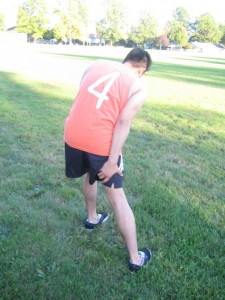There are several factors including knee injuries, muscular overuse, joint disorders and back injuries that can trigger outer thigh soreness and pain. Before you will try to treat the soreness, it is best to consult a doctor first so that proper assessment can be carried out in order to determine the source of the pain.
Overuse
Always bear in mind that outer thigh soreness can often be caused by overuse. If the individual engages in strenuous exercises for the outer thigh than the inner thigh, it can lead to a muscular imbalance which can lead to the distortion of the movement mechanics. Additionally, this will lead to postural misalignment as well as chronic pain. With this in mind, the individual should engage in well-balanced exercises for the thigh and to avoid overdoing them.

Meralgia paresthetica
The numbness, tingling and burning sensation in the outer thigh simply indicates meralgia paresthica. The condition is caused by the compression of the nerve that supplies sensation to the outer thigh. The common causes of this condition include pregnancy, weight gain and wearing constricted clothing.
Those who use a heavy tool belt or using a tight girdle are prone to develop this condition. The treatment for this condition typically involves the removal of the cause of the compression. In most cases, the doctor will recommend wearing loose clothing, weight loss or using a tool box instead of a tool belt.
Bursitis
Bursitis is basically the inflammation of the fluid-filled sacs that are positioned in the upper part of the thigh bone. Take note that these sacs or bursae are responsible for cushioning the space between the tendons, muscles as well as the bones of the thighs and hips. The irritation to these parts can lead to pain and inflammation which can start in the hip and spread down to the exterior part of the thigh. The pain will make it difficult for the individual to use the stairs or sleep using the affected side. Unusual standing and walking configurations can also cause bursitis. If you want to learn more about measures to relieve the pain, click here.
Iliotibial band syndrome
The iliotibial band or IT band traverses down the exterior part of the thigh and responsible for the stability of the pelvis. Prolonged running or climbing can trigger iliotibal band syndrome. Take note that the pain often starts in the lateral side of the knee when the IT band pulls against the knee, causing inflammation on the bursa sac situated in the knee. The pain can originate in the outer knee and spread upward to the whole outer thigh. The individual should rest sideways on a foam roller and gently roll back and forth in order to reduce the pain. Adjusting the training schedule can help prevent the recurrence of the condition.
